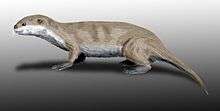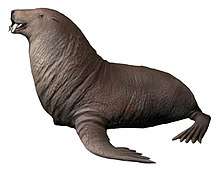Earless seal
The earless seals, phocids or true seals are one of the three main groups of mammals within the seal lineage, Pinnipedia. All true seals are members of the family Phocidae /ˈfoʊsɪdiː/. They are sometimes called crawling seals to distinguish them from the fur seals and sea lions of the family Otariidae. Seals live in the oceans of both hemispheres and, with the exception of the more tropical monk seals, are mostly confined to polar, subpolar, and temperate climates. The Baikal seal is the only species of exclusively freshwater seal.
| Earless seals[1] | |
|---|---|
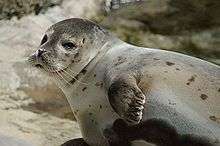 | |
| Harbor seal, Phoca vitulina | |
| Scientific classification | |
| Kingdom: | Animalia |
| Phylum: | Chordata |
| Class: | Mammalia |
| Order: | Carnivora |
| Clade: | Pinnipediformes |
| Clade: | Pinnipedia |
| Superfamily: | Phocoidea |
| Family: | Phocidae Gray, 1821 |
| Subfamilies | |
Refer to the article's text about the interrelationships among the phocid subfamilies. | |
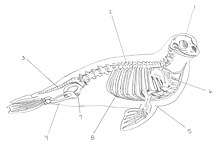
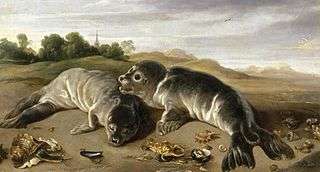
Systematics
Evolution
The earliest known fossil earless seal is Noriphoca gaudini from the late Oligocene or earliest Miocene (Aquitanian) of Italy.[2] Other early fossil phocids date from the mid-Miocene, 15 million years ago in the north Atlantic.[2][3] Until recently, many researchers believed that phocids evolved separately from otariids and odobenids; and that they evolved from otter-like animals, such as Potamotherium, which inhabited European freshwater lakes. Recent evidence strongly suggests a monophyletic origin for all pinnipeds from a single ancestor, possibly Enaliarctos, most closely related to the mustelids and bears.[4]
Monk seals and elephant seals are believed to have first entered the Pacific through the open straits between North and South America, which only closed in the Pliocene.[5] The various Antarctic species may have either used the same route, or traveled down the west coast of Africa.[6]
Taxonomy
In the 1980s and 1990s, morphological phylogenetic analysis of the phocids led to new conclusions about the interrelatedness of the various genera. More recent molecular phylogenetic analyses have confirmed the monophyly of the two phocid subfamilies (Phocinae and Monachinae).[7][8][9][5] The Monachinae (known as the "southern" seals), is composed of three tribes; the Lobodontini, Miroungini, and Monachini. The four Antarctic genera Hydrurga, Leptonychotes, Lobodon, and Ommatophoca are part of the tribe Lobodontini. Tribe Miroungini is composed of the elephant seals. The Monk seals (Monachus and Neomonachus) are all part of the tribe Monachini.[10] Likewise, subfamily Phocinae (the "northern" seals) also includes three tribes; Erignathini (Erignathus), Cystophorini (Cystophora), and Phocini (all other phocines). More recently, five species have been split off from Phoca, forming three additional genera.[11]
Alternatively the three monachine tribes have been evaluated to familiar status, which elephant seals and the Antarctic seals are more closely related to the phocines.[12]
| |||||||||||||||||||||||||||||||||||||||||||||||||||||||||||||||||||||||||||||||||||||||||||||||||||||||||
| Cladogram showing relationships among the extant earless seals, combining several phylogenetic analyses.[13] |
Extant genera
| Subfamily | Tribe | Image | Genus | species |
|---|---|---|---|---|
| Subfamily Monachinae | Tribe Monachini | 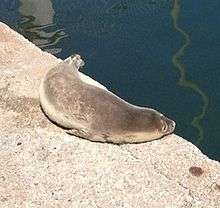 | Monachus Fleming, 1822 |
|
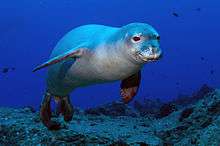 | Neomonachus Slater & Helgen, 2014 |
| ||
| Tribe Miroungini | .jpg) | Mirounga Gray, 1827 |
| |
| Tribe Lobodontini |  | Ommatophoca Gray, 1844 |
| |
.jpg) | Lobodon Gray, 1844 |
| ||
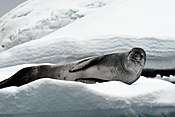 | Hydrurga Gistel, 1848 |
| ||
.jpg) | Leptonychotes Gill, 1872 |
| ||
| Subfamily Phocinae | Tribe Cystophorini | 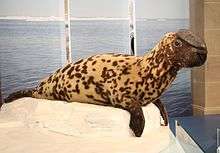 | Cystophora Nilsson, 1820 |
|
| Tribe Erignathini | .jpg) | Erignathus Gill, 1866 |
| |
| Tribe Phocini | 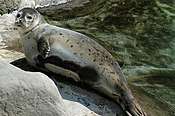 | Phoca Linnaeus, 1758 |
| |
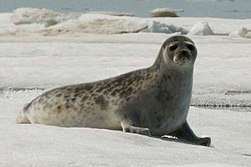 | Pusa Scopoli, 1771 |
| ||
.jpg) | Pagophilus Gray, 1844 |
| ||
_(cropped).jpg) | Histriophoca Gill, 1873 |
| ||
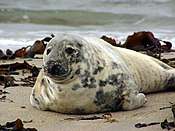 | Halichoerus Nilsson, 1820 |
| ||
Biology
External anatomy
Adult phocids vary from 1.17 m (3.8 ft) in length and 45 kg (99 lb) in weight in the ringed seal to 4.9 m (16 ft) and 2,400 kg (5,300 lb) in land-based members of the Carnivora, although they retain powerful canines. Some species lack molars altogether. The dental formula is: 2–3.1.4.0–21–2.1.4.0–2
While otariids are known for speed and maneuverability, phocids are known for efficient, economical movement. This allows most phocids to forage far from land to exploit prey resources, while otariids are tied to rich upwelling zones close to breeding sites. Phocids swim by sideways movements of their bodies, using their hind flippers to fullest effect.[14] Their fore flippers are used primarily for steering, while their hind flippers are bound to the pelvis in such a way that they cannot bring them under their bodies to walk on them. They are more streamlined than fur seals and sea lions, so they can swim more effectively over long distances. However, because they cannot turn their hind flippers downward, they are very clumsy on land, having to wriggle with their front flippers and abdominal muscles.
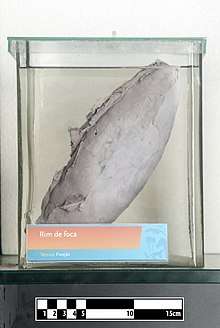
Phocid respiratory and circulatory systems are adapted to allow diving to considerable depths, and they can spend a long time underwater between breaths. Air is forced from the lungs during a dive and into the upper respiratory passages, where gases cannot easily be absorbed into the bloodstream. This helps protect the seal from the bends. The middle ear is also lined with blood sinuses that inflate during diving, helping to maintain a constant pressure.[14]
Phocids are more specialized for aquatic life than otariids. They lack external ears and have sleek, streamlined bodies. Retractable nipples, internal testicles,[15] and an internal penile sheath provide further streamlining. A smooth layer of blubber lies underneath the skin. Phocids are able to divert blood flow to this layer to help control their temperatures.
Communication
Unlike otariids, true seals do not communicate by 'barking'. Instead, they communicate by slapping the water and grunting.
Reproduction
.jpg)
Phocids spend most of their time at sea, although they return to land or pack ice to breed and give birth. Pregnant females spend long periods foraging at sea, building up fat reserves, and then return to the breeding site to use their stored energy to nurse pups. However, the common seal displays a reproductive strategy similar to that used by otariids, in which the mother makes short foraging trips between nursing bouts.
Because a phocid mother's feeding grounds are often hundreds of kilometers from the breeding site, she must fast while lactating. This combination of fasting with lactation requires the mother to provide large amounts of energy to her pup at a time when she is not eating (and often, not drinking). Mothers must supply their own metabolic needs while nursing. This is a miniature version of the humpback whales' strategy, which involves fasting during their months-long migration from arctic feeding areas to tropical breeding/nursing areas and back.
Phocids produce thick, fat-rich milk that allows them to provide their pups with large amounts of energy in a short period. This allows the mother to return to the sea in time to replenish her reserves. Lactation ranges from five to seven weeks in the monk seal to just three to five days in the hooded seal. The mother ends nursing by leaving her pup at the breeding site to search for food (pups continue to nurse if given the opportunity). "Milk stealers" that suckle from unrelated, sleeping females are not uncommon; this often results in the death of the mother's pup, since a female can only feed one pup.
Growth and maturation
The pup's diet is so high in calories, it builds up a fat store. Before the pup is ready to forage, the mother abandons it, and the pup consumes its own fat for weeks or even months while it matures. Seals, like all marine mammals, need time to develop the oxygen stores, swimming muscles, and neural pathways necessary for effective diving and foraging. Seal pups typically eat no food and drink no water during the period, although some polar species eat snow. The postweaning fast ranges from two weeks in the hooded seal to 9–12 weeks in the northern elephant seal.[16] The physiological and behavioral adaptations that allow phocid pups to endure these remarkable fasts, which are among the longest for any mammal, remain an area of active study and research.
Feeding strategy
Phocids make use of at least four different feeding strategies: suction feeding, grip, and tear feeding, filter feeding, and pierce feeding. Each of these feeding strategies is aided by a specialized skull, mandible, and tooth morphology. However, despite morphological specialization, most phocids are opportunistic and employ multiple strategies to capture and eat prey. For example, the leopard seal, Hydrurga leptonyx, uses grip and tear feeding to prey on penguins, suction feeding to consume small fish, and filter feeding to catch krill.[17]
See also
References
- Wozencraft, W.C. (2005). "Order Carnivora". In Wilson, D.E.; Reeder, D.M (eds.). Mammal Species of the World: A Taxonomic and Geographic Reference (3rd ed.). Johns Hopkins University Press. ISBN 978-0-8018-8221-0. OCLC 62265494.
- Leonard Dewaele; Olivier Lambert; Stephen Louwye (2018). "A critical revision of the fossil record, stratigraphy and diversity of the Neogene seal genus Monotherium (Carnivora, Phocidae)". Royal Society Open Science. 5 (5): 171669. Bibcode:2018RSOS....571669D. doi:10.1098/rsos.171669. PMC 5990722. PMID 29892365.
- Dewaele, Leonard; Lambert, Olivier; Louwye, Stephen (2017-02-21). "On Prophoca and Leptophoca (Pinnipedia, Phocidae) from the Miocene of the North Atlantic realm: redescription, phylogenetic affinities and paleobiogeographic implications". PeerJ. 5: e3024. doi:10.7717/peerj.3024. ISSN 2167-8359. PMC 5322758. PMID 28243538.
- Paterson, Ryan S.; Rybczynski, Natalia; Kohno, Naoki; Maddin, Hillary C. (2020). "A Total Evidence Phylogenetic Analysis of Pinniped Phylogeny and the Possibility of Parallel Evolution Within a Monophyletic Framework". Frontiers in Ecology and Evolution. 7. doi:10.3389/fevo.2019.00457. ISSN 2296-701X.
- Fulton, Tara L.; Strobeck, Curtis (2010). "Multiple fossil calibrations, nuclear loci and mitochondrial genomes provide new insight into biogeography and divergence timing for true seals (Phocidae, Pinnipedia)". Journal of Biogeography. 37 (5): 814–829. doi:10.1111/j.1365-2699.2010.02271.x. ISSN 1365-2699.
- Savage, RJG & Long, MR (1986). Mammal Evolution: an illustrated guide. New York: Facts on File. pp. 94–95. ISBN 978-0-8160-1194-0.
- Árnason, Úlfur; Bodin, Kristina; Gullberg, Anette; Ledje, Christina; Suzette, Mouchaty (1995-01-01). "A molecular view of pinniped relationships with particular emphasis on the true seals". Journal of Molecular Evolution. 40 (1): 78–85. Bibcode:1995JMolE..40...78A. doi:10.1007/BF00166598. ISSN 1432-1432. PMID 7714914.
- Arnason, Ulfur; Gullberg, Anette; Janke, Axel; Kullberg, Morgan; Lehman, Niles; Petrov, Evgeny A.; Väinölä, Risto (2006-11-01). "Pinniped phylogeny and a new hypothesis for their origin and dispersal". Molecular Phylogenetics and Evolution. 41 (2): 345–354. doi:10.1016/j.ympev.2006.05.022. ISSN 1055-7903. PMID 16815048.
- Fulton, Tara Lynn; Strobeck, Curtis (2010-04-07). "Multiple markers and multiple individuals refine true seal phylogeny and bring molecules and morphology back in line". Proceedings of the Royal Society B: Biological Sciences. 277 (1684): 1065–1070. doi:10.1098/rspb.2009.1783. PMC 2842760. PMID 19939841.
- Scheel, Dirk-Martin; Slater, Graham J.; Kolokotronis, Sergios-Orestis; Potter, Charles W.; Rotstein, David S.; Tsangaras, Kyriakos; Greenwood, Alex D.; Helgen, Kristofer M. (2014-05-14). "Biogeography and taxonomy of extinct and endangered monk seals illuminated by ancient DNA and skull morphology". ZooKeys (409): 1–33. doi:10.3897/zookeys.409.6244. ISSN 1313-2989. PMC 4042687. PMID 24899841.
- Berta, Annalisa; Churchill, Morgan (2012). "Pinniped taxonomy: review of currently recognized species and subspecies, and evidence used for their description". Mammal Review. 42 (3): 207–234. doi:10.1111/j.1365-2907.2011.00193.x. ISSN 1365-2907.
- Bonner, N. (1994). Seals and Sea Lions of the World. United Kingdom: Blandford. pp. 1–224. ISBN 9780816057177.
- Berta, A.; Churchill, M. (2012). "Pinniped taxonomy: Review of currently recognized species and subspecies, and evidence used for their description". Mammal Review. 42 (3): 207–34. doi:10.1111/j.1365-2907.2011.00193.x.
- McLaren, Ian (1984). Macdonald, D. (ed.). The Encyclopedia of Mammals. New York: Facts on File. pp. 270–275. ISBN 978-0-87196-871-5.
- William F. Perrin; Bernd Würsig; J.G.M. Thewissen (26 February 2009). Encyclopedia of Marine Mammals. Academic Press. ISBN 978-0-08-091993-5.
- Costa, D. P.; Boeuf, B. J. Le; Huntley, A. C.; Ortiz, C. L. (1986-03-01). "The energetics of lactation in the Northern elephant seal, Mirounga angustirostris". Journal of Zoology. 209 (1): 21–33. doi:10.1111/j.1469-7998.1986.tb03563.x. ISSN 1469-7998.
- Kienle, Sarah S.; Berta, Annalisa (2016). "The better to eat you with: the comparative feeding morphology of phocid seals (Pinnipedia, Phocidae)". Journal of Anatomy. 228 (3): 396–413. doi:10.1111/joa.12410. ISSN 1469-7580. PMC 5341551. PMID 26646351.
External links
| Wikispecies has information related to Phocidae |
| Wikimedia Commons has media related to: |
